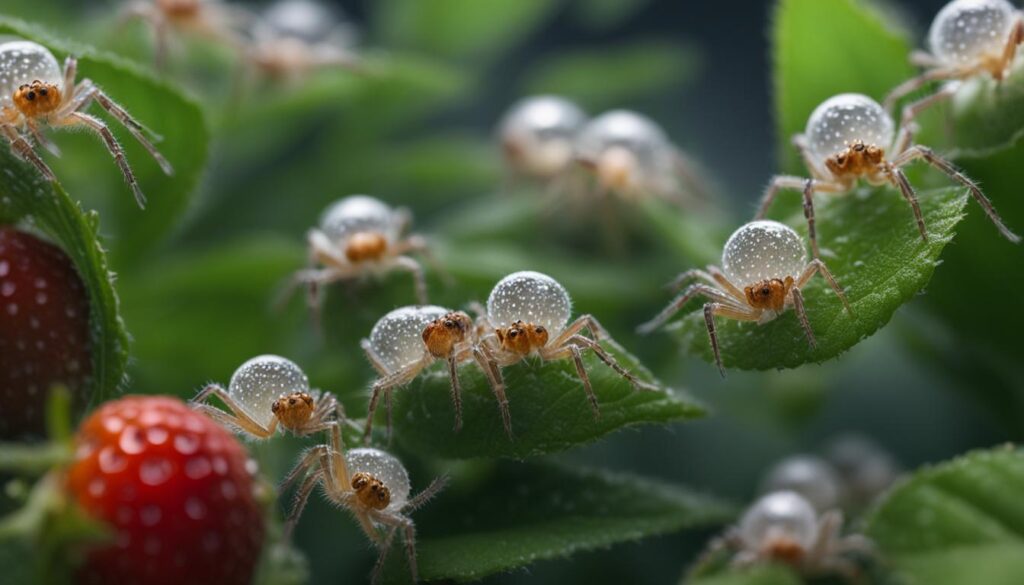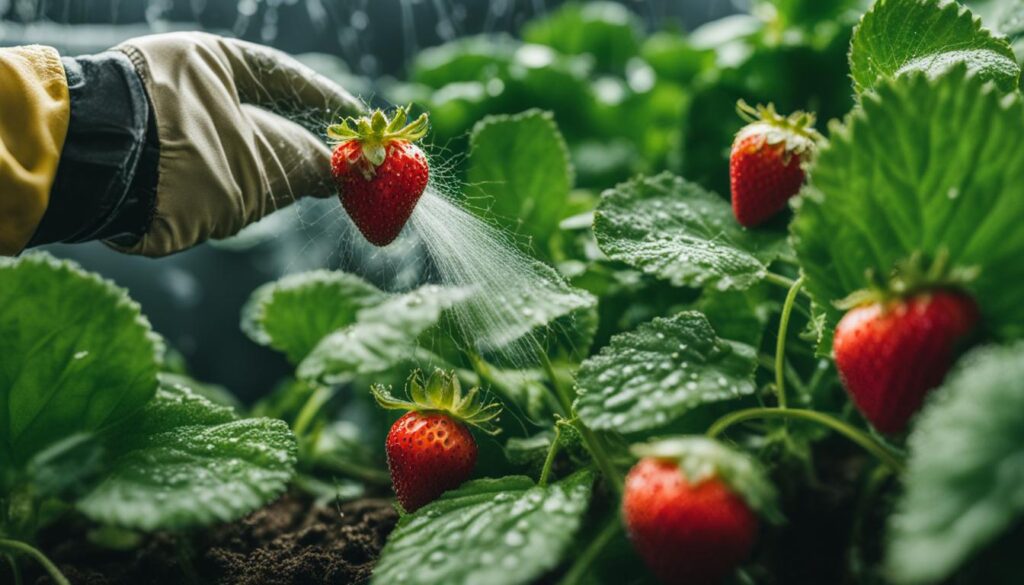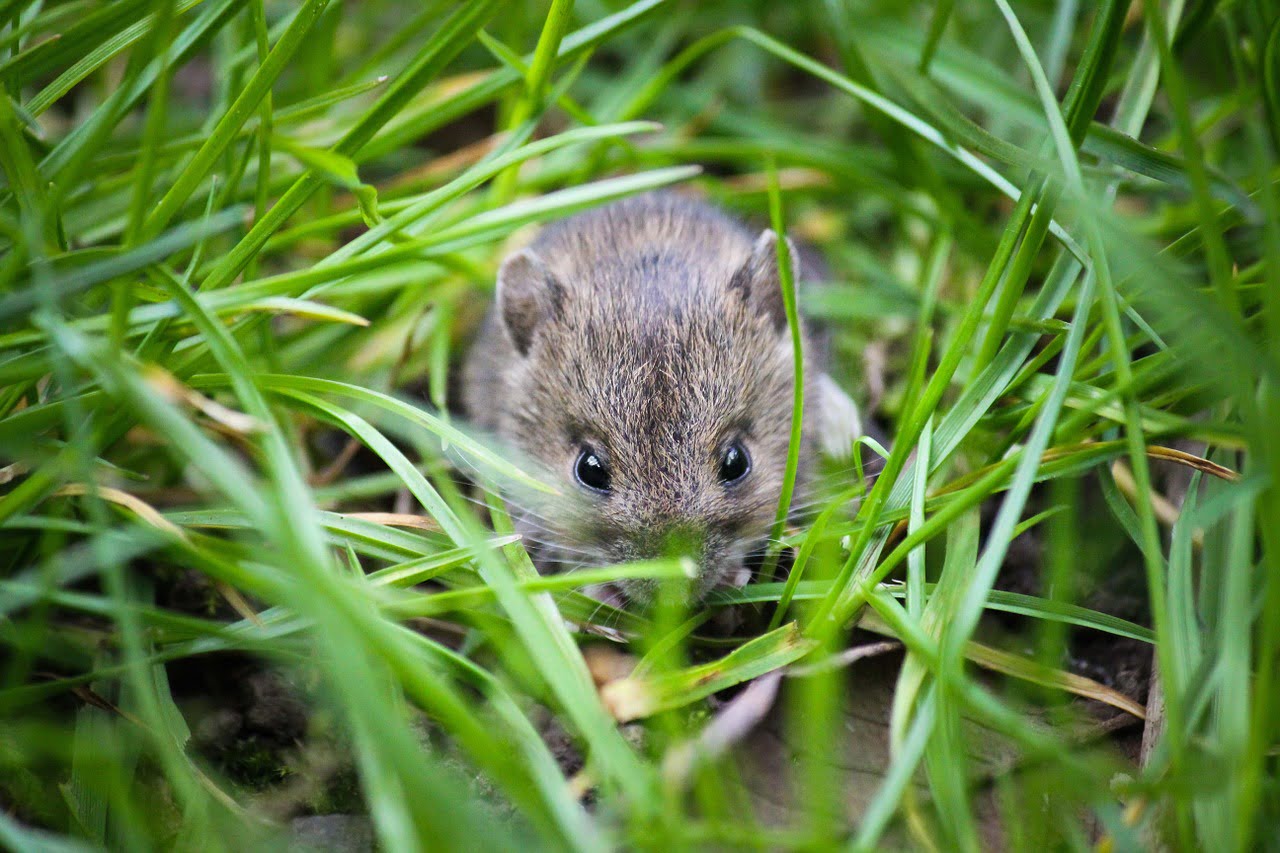Are spiders ruining your strawberry plants? Don’t worry, we’ve got you covered. In this guide, we’ll show you how to effectively get rid of spiders and their pesky relatives, spider mites, so you can enjoy a bountiful harvest of delicious strawberries.
Post Summary
- Spider mites are tiny arachnids that feed on plant fluids and cause damage to strawberry plants.
- Spider mites are most common in hot and dry conditions, and their infestations can quickly worsen.
- Regular inspection, prevention, and proper watering are essential to spot and control spider mite damage.
- Natural methods such as pruning, washing with water, and releasing beneficial insects can effectively manage spider mite infestations.
- Organic insecticides like Nuke Em and BotaniGard ES are also effective in controlling spider mites.
What are Spider Mites?
Spider mites are common pests that can pose a threat to your plants, particularly during the warmer months. These tiny arachnids, not insects, belong to the Tetranychidae family and are smaller than the head of a pin. With over 1600 species worldwide, the two-spotted spider mite and the red spider mite are the most prevalent in the United States.
Unlike spiders, spider mites are not beneficial predators; they are plant feeders that thrive in hot and dry conditions. When the weather warms up in the spring, spider mites come out and quickly reproduce, making them a formidable enemy to your garden. Their rapid development and ability to reproduce in large numbers make them a common problem for gardeners.
Spider mites are smaller than the head of a pin and classified as arachnids, not insects.
It’s important to understand that spider mites can cause significant damage to your plants if left unchecked. Their feeding habits involve piercing the leaf tissue and sucking out plant fluids, leaving behind light dots on the leaves. As the infestation worsens, the affected leaves turn yellow and may dry up entirely. Additionally, spider mites can create tight webs on leaves and stems, further hindering the plant’s growth and health.
What Makes Spider Mites Common Pests?
Spider mites are exceptionally prolific and can cause heavy infestations before visible damage becomes apparent. With their small size and ability to reproduce rapidly, they can quickly overwhelm a garden if not properly managed. Furthermore, their preference for hot and dry conditions, coupled with the absence of natural enemies due to insecticide use, contributes to their prevalence as common garden pests.
To effectively protect your plants from spider mite damage, it’s crucial to not only understand their behavior but also employ suitable prevention and control methods. By learning how to spot and prevent spider mite damage, as well as implementing natural control measures, you can keep your garden healthy and free from these arachnid invaders.
Life Cycle of Spider Mites
Understanding the life cycle of spider mites is crucial in effectively managing and controlling these common pests. Spider mite eggs overwinter on leaves and bark during the colder months. As the weather warms up in early spring, tiny larvae hatch and begin to feed on the plant’s foliage. These larvae then molt into the first nymphal stage, and over the course of several weeks, they go through two more molts to become mature adults.
Female adult spider mites are incredibly prolific, laying up to 300 eggs in a couple of weeks. This rapid reproduction cycle allows spider mite populations to grow exponentially in a short period. In hot and dry weather conditions, spider mites can develop from eggs to adulthood in as little as 5 days, leading to multiple generations occurring within a single year.
To summarize, the life cycle of spider mites consists of the following stages:
- Eggs overwinter on leaves and bark
- Tiny larvae hatch and feed on plant foliage
- Larvae molt into first nymphal stage
- Nymphs go through two more molts
- Mature adults emerge and lay up to 300 eggs
Now that you have a better understanding of the life cycle of spider mites, it becomes easier to implement effective control measures to disrupt their breeding and minimize their impact on your plants.
Damage Caused by Spider Mites
Spider mites may be small, but their feeding habits can lead to significant damage in plants. As they suck sap from the underside of leaves, they cause yellow spots, leaf curling, and even leaf drop. These feeding marks appear as light dots on the leaves, which can be an early indicator of a spider mite infestation.
One of the distinguishing characteristics of spider mites is the webbing they produce. These pests create tight webs on leaves and stems, which can further damage plants by restricting their growth and blocking essential sunlight. Heavy infestations of spider mites can be particularly harmful to crops like squash, melons, and sugar peas, affecting both the appearance and yield of the plants.
While spider mites are primarily considered an aesthetic concern for ornamental plants, they can become a serious threat if their populations become very high. In such cases, they can cause plant stress and even lead to the death of the affected plants.
Comparing Damage Caused by Spider Mites
| Damage | Ornamental Plants | Crops |
|---|---|---|
| Yellow spots on leaves | ✓ | ✓ |
| Leaf curling | ✓ | ✓ |
| Leaf drop | ✓ | ✓ |
| Webbing on leaves and stems | ✓ | ✓ |
| Plant stress | ✓ | ✓ |
| Plant death | ✓ | ✓ |
How to Spot and Prevent Spider Mite Damage
When it comes to protecting your plants from spider mite damage, early detection is key. Regularly inspect your plants for signs of infestation, such as yellow or white spots on the leaves. To get a closer look, use a magnifying glass or gently tap the leaves onto a white piece of paper to check for webbing and mites. By catching the infestation early, you can take prompt action to prevent further damage.
Isolation is another effective strategy to prevent the spread of spider mites. If you notice an infested plant, immediately remove it from the vicinity of other plants. This will help contain the mites and prevent them from moving on to other healthy plants. Isolation can significantly reduce the risk of an infestation spreading throughout your garden or indoor space.
In addition to inspection and isolation, proper watering practices can also help prevent plant stress and make them less susceptible to spider mite infestations. Spider mites thrive in hot and dry conditions, so it’s important to keep your plants well-hydrated. However, be careful not to overwater, as this can create a breeding ground for other pests and diseases. Finding the right balance is essential.
Remember, prevention is always better than a cure when it comes to spider mite damage. By regularly inspecting your plants, isolating infested ones, and maintaining proper watering practices, you can significantly reduce the risk of a spider mite infestation.
Common Signs of Spider Mite Damage
| Signs of Spider Mite Damage | Description |
|---|---|
| Yellow or white spots on leaves | Spider mites feed on plant cells, causing discoloration and spots on the leaves. |
| Webbing on leaves and stems | Spider mites produce fine webs as they move and feed, which can be seen on the surface of the plant. |
| Curling or wilting leaves | Severe infestations can cause leaves to curl, wilt, or even drop prematurely. |
| Stunted growth | Spider mite feeding can inhibit the growth and development of plants, resulting in smaller, less healthy specimens. |
By familiarizing yourself with these common signs of spider mite damage, you’ll be able to take swift action if an infestation occurs. Remember, early detection and prevention are the keys to maintaining healthy, thriving plants.
How to Control and Get Rid of Spider Mites
If you’re dealing with a spider mite infestation on your strawberries or plants, it’s important to take immediate action to control and get rid of these pests. Fortunately, there are several natural methods that can effectively manage spider mite populations without relying on chemical pesticides.
Pruning
One effective method to control spider mites is by pruning infested parts of the plants. Start by removing heavily infested leaves and stems, making sure to dispose of them properly to prevent further spread. Pruning not only removes the mites but also helps improve air circulation, which can discourage their growth and reproduction.
Beneficial Insects
Another natural way to control spider mites is by introducing beneficial insects into your garden. Ladybugs and lacewings are natural predators of spider mites and can help keep their populations in check. You can purchase these insects from garden centers or online and release them onto your infested plants. They’ll feast on the mites and help restore the natural balance in your garden.
Horticultural Oils
Horticultural oils, such as neem oil and insecticidal soaps, are effective in controlling spider mites. They work by suffocating the mites and disrupting their cell membranes. To use horticultural oils, make sure to follow the instructions on the product label and apply them when the weather is cool, preferably early in the morning or late in the evening. Be sure to coat the leaves and stems thoroughly to ensure complete coverage.
Using these natural methods in combination can significantly reduce spider mite populations and protect your strawberries and other plants. Remember to monitor your plants regularly and take action at the first sign of infestation to prevent further damage. By employing these natural control methods, you can enjoy a healthy and thriving garden free from spider mites.
| Natural Methods for Spider Mite Control | Pros | Cons |
|---|---|---|
| Pruning |
|
|
| Beneficial Insects |
|
|
| Horticultural Oils |
|
|
Conclusion
Getting rid of spiders in strawberries is crucial for maintaining the health and productivity of your plants. By following a few simple steps, you can effectively control and prevent spider mite infestations in your strawberry patch.
Regular inspection is key to spotting spider mite damage early on. Look for yellow or white spots on the leaves and check for webbing and mites using a magnifying glass or by tapping the leaves onto a white paper. Isolating infested plants can help prevent the spread of spider mites to other healthy plants.
Implementing proper watering techniques is essential in preventing plant stress and making your strawberries less susceptible to spider mite infestations. Additionally, consider natural methods such as pruning affected parts of the plant, washing the plants with a strong stream of water, and introducing beneficial insects like ladybugs and lacewings.
If the infestation is severe, you can use horticultural oils, insecticidal soaps, or organic insecticides to spot treat the affected areas. Remember to always avoid the use of chemical pesticides as they may contribute to the spread and resistance of spider mites.
FAQ
What are spider mites?
Spider mites are tiny sucking pests that are closely related to spiders and ticks. They live in colonies on the underside of leaves and feed by piercing leaf tissue and sucking plant fluids.
How can I identify spider mite damage?
Spider mite damage appears as light dots on leaves, which turn yellow and may dry up as the infestation worsens. They also create tight webs on leaves and stems.
How do spider mites reproduce?
Spider mite species overwinter as eggs on leaves and bark. In early spring, tiny larvae hatch and go through several molts before becoming mature adults. Female adults lay up to 300 eggs in a couple of weeks.
What are the best methods to prevent spider mite damage?
Regularly inspect plants for signs of spider mite damage, such as yellow or white spots on leaves. Proper watering and isolating infested plants can also help prevent infestations.
How can I control and get rid of spider mites?
Natural methods like pruning infested parts of plants, washing with water, and releasing beneficial insects like ladybugs and lacewings can help control spider mites. Horticultural oils and insecticidal soaps can be used as spot treatments. Organic insecticides are also effective.
Will Getting Rid of Ants Help Keep Spiders Away from Strawberry Plants?
Getting rid of ants around strawberry plants can potentially help keep spiders away. Ants and spiders both prey on smaller insects, and if there are fewer ants to attract spiders, they may not be as likely to build webs near your strawberries. A balanced ants and strawberry plants relationship can help with natural pest control.












